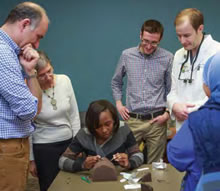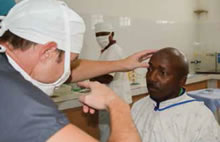The idea for what is now called Global Ophthalmology at Emory (GO-Emory) originated in 2009 when Danny Haddad, then director of the International Trachoma Initiative (ITI), joined Emory Eye Center Director Timothy Olsen and faculty member Paul Courtright in a seminal conversation about building a global vision initiative at Emory.
The idea took hold, aided by some dedicated advocates and partners, both within Emory — Emory Global Health is a key partner — and among Atlanta organizations such as ITI, The Carter Center, and the CDC, and with vision-focused groups such as the Lions Lighthouse and Center for the Visually Impaired.
Haddad joined the faculty as the program's full-time director in 2013 and continues the work of those who helped get it off the ground, working with local, national, and international organizations to advance vision-related public health goals.
"Dr. Haddad brings a wealth of knowledge and global connections to Emory," says Olsen. "He is a well-respected international leader in trachoma and has created a remarkable track record in effective public health strategies to help eradicate this blinding disorder. We are very fortunate to have him as our first director of Global Ophthalmology at Emory."
Local Efforts
Haddad's vision for GO-Emory focuses considerable attention on local needs in Georgia. His goal is to eliminate avoidable blindness through GO-Emory's Vision 2020 Georgia project, which aligns with Vision 2020, the right-to-sight initiative of the World Health Organization (WHO) and the International Agency for the Prevention of Blindness, to eliminate avoidable blindness globally by 2020. Locally, GO-Emory will work in partnership with the Georgia Vision Collaborative.
WHO and some 20 international non-government organizations provide guidance and technical and resource screened 177 children for vision problems and eye disease and found problems in 25% of the children. Lenhart and Russ saw 40 children in follow-up exams; 68% subsequently received glasses from the Georgia Lions Lighthouse.

A vision health course at Emory's Rollins School of Public Health gives students insight into the complexities of eye surgery and the burden of eye disease on populations around the world.
In other work close to home, Haddad leads a course in Emory's Rollins School of Public Health to teach students about the burden of eye disease in this and other countries. The course, "Vision Health: A Global Perspective," now in its third year, continues to grow in enrollment. Representatives of Prevent Blindness Georgia and the Georgia Lions Lighthouse, among others, join Haddad, Courtright, Lewallen, and other ophthalmology faculty in contributing to the course. support to countries whose people are affected by trachoma and other preventable and/or treatable eye diseases.
Through GO-Emory initiatives, Haddad's five-year plan is to bring the same kind of resources to Georgia, where considerable challenges exist to provide vision care to populations who desperately need it, yet are left out because of vast disparities in access. Many Georgians who have a potentially blinding disorder may be unaware of their condition. Glaucoma, for example, has no early symptoms. It is typically detected during a comprehensive eye exam. Haddad stresses that a plan to fill in the gaps for provision of eye care is absolutely necessary in Georgia for adults and children in at-risk populations.
Efforts Abroad
Over the past year, GO-Emory physicians have traveled to various destinations around the globe to treat patients and provide training to clinicians there. More than 80% of blindness in developing countries is avoidable or curable.
Madagascar
A team of four Emory Eye Center physicians traveled to this country this year, for the second year in a row, with a dual mission of fact finding and helping train local ophthalmologists in clinics in Antsirabe and in Antananarivo (Tana), the capital. The team included oculoplastics surgeon Brent Hayek, glaucoma expert Annette Giangiacomo, and pediatric ophthalmologist Phoebe Lenhart. Hayek says conditions there are a challenge for those needing eye care: there are only 25 to 35 ophthalmologists in Madagascar to serve some 20 million people.

Emory physician providing eyecare in Madagascar. There are only 25 to 35 ophthalmologists in the countryof some 20 million people.
Hayek taught local ophthalmologists practical oculoplastic procedures by performing and supervising more than a dozen surgeries. Giangiacomo worked with local ophthalmologists to train them in current glaucoma treatments, and Lenhart performed surgeries on children in the region.
Hoping to make this a long-term initiative, GO-Emory made meaningful connections with governmental and academic organizations, including the Malagasy Ophthalmology Society, the Residency Eye Program in Tana and the non-communicable disease department of the Ministry of Health.
Note: Funding for the trip to Madagascar was made possible by Emory Eye Center Advisory Board member Gordon Knight and by Marguerite Kimball, of Atlanta. Advisory Board member Charles Ginden also provided support for the project.
Ethiopia
Third-year ophthalmology resident Christopher Skelton joined previous residency program director Paul Pruett in a medical rotation at the University of Addis Ababa in Ethiopia's capital city. Pruett and Skelton taught in the government hospital — not unlike Grady Memorial Hospital in Atlanta — in hopes of forging a partnership with the department of ophthalmology.
Teaching some 18 residents in the university's four-year program, they observed a scarcity of resources in the clinics. Privacy was not possible: often 10 patients were in one exam room, and teaching occurred in front of everyone — physicians, patients, family members, and others. All surgical instruments were sterilized and re-used, whereas in developed countries like the United States, such instruments are largely disposable. "These physicians have learned how to do a lot with very little," says Pruett.
Vietnam
Haddad recently traveled to this country, where historically women have had little access to health care. As a result, trachoma has been very prevalent, many children having contracted it from their mothers or vice versa. Today's outlook is far better than in the past. As Haddad says, "We're closing in on eliminating blinding trachoma in Vietnam."

